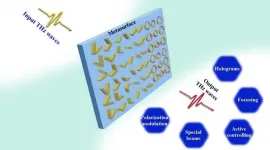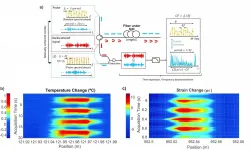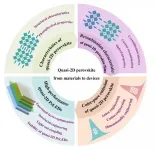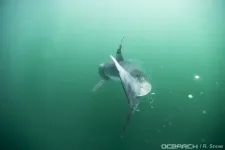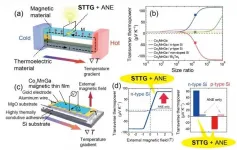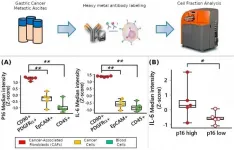Underwater swimming robot responds with feedback from soft 'lateral line'
2021-03-23
(Press-News.org) Stuttgart - A team of scientists from the Max Planck Institute for Intelligent Systems (MPI-IS) in Germany, from Seoul National University in Korea and from the Harvard University in the US, successfully developed a predictive model and closed-loop controller of a soft robotic fish, designed to actively adjust its undulation amplitude to changing flow conditions and other external disturbances. Their work "Modeling and Control of a Soft Robotic Fish with Integrated Soft Sensing" was published in Wiley's Advanced Intelligent Systems journal, in a special issue on "Energy Storage and Delivery in Robotic Systems".
Each side of the robotic fish is lined with soft artificial muscles made of rubber-like small silicone chambers. Through these pockets, the researchers pumped air alternately on each side. While the air pockets on one side expand, they create a curvature, contracting the air pockets on the other side. This causes the robotic fish to bend right and left, swinging its tail, resembling the wave-like movement pattern seen by real fish.
To measure the bending, the scientists embedded state of the art soft strain sensors, consisting of a thin layer of windy microchannels filled with liquid metal and encapsulated in silicone. What was now like a wire, could stretch like a phone cord to a length of 900%. The more the air pressurized each silicone chamber of the actuator, the more the sensor placed atop the bends, and its liquid metal 'wire' was elongated. The scientists then connected the sensor to an Ohmmeter to measure the electrical resistance. The greater the stretching elongation, the higher the electrical resistance within the 'wire'. This number provided the scientists with data of how the curvature of their robotic fish changed given a certain change of air pressure.
The scientists then put this robotic fish platform under water in a flow tank. In several experiments they tested how the air pressure controller took the reading from the sensor to measure the swimming performance of the robot - an information loop that was feeding a self-learning algorithm inside the controller to push just the right amount of air through the pneumatic pockets so the swimming perfectly matched the different water flow velocities.
"We developed a hydrodynamic model that can predict how our soft robotic fish will behave. This builds upon previous findings where we measured peak thrust during swimming with co-contraction and body stiffening, and tested soft sensors in feedforward undulatory motion. Closing the loop with proprioceptive soft sensory feedback allows the robot to respond to different flow conditions,", Ardian Jusufi explains. He is the corresponding author of the publication and specializes on soft active materials, biomimetics, and robotics. Jusufi is the head of the Max Planck Cyber Valley research group for "Locomotion in Biorobotic and Somatic Systems" at the MPI-IS. "Our project builds upon several previous collaborative papers on soft robots and biorobotic modeling of swimming robots. To advance modeling and closed-loop control, our team has combined soft robotics expertise from three continents."
"In this work, we have used a simple approach to build a data-driven model of a soft robotic fish, and extended it with the controller design. This model could also be easily extended without the need of completely rebuilding it, for example to study the scaling effects of robots or testing different types of sensing techniques.", describes Yu-Hsiang Lin of the Locomotion in Biorobotic and Somatic Systems" group at the MPI-IS, and first author.
In their publication, the scientists describe the sensors as a completely new design technique, labelling them "hyper-elastic liquid metal strain sensors." Developed by Prof. Yong-Lae Park and his team at Seoul National University, and Daniel Vogt from Harvard University, they are a true innovation. "In biology as well as in soft robotics, with an entirely soft robot, we have infinite degrees of freedom. That means any part of the body can deform. It is hard to estimate how the fish's shape changes, because we cannot put an indefinite number of sensors onto its body, as it would be possible with rigid robots with a limited number of joints," Park says.
"This robot will allow us to test and refine hypotheses regarding the neuromechanics of swimming animals as well as help us improve future underwater robots," Jusufi continues. "In addition to characterizing the soft strain sensor under submerged dynamic conditions for the first time, we also developed a simple and flexible data-driven modelling approach in order to design our swimming feedback controller. The model will be of interest to the scientific community and will help accelerate future work in design and operation of soft robots. In forthcoming research, we will also utilize soft strain sensors in terrestrial robots that climb and can overcome complex obstacles."
Understanding the underlying mechanisms how soft animals like fish swim helps in designing artificial soft structures and make it possible to use them to build robots. Such animal-inspired robots could one day be used to explore the depths of the sea and provide valuable data of marine life, avoiding noise and reducing the risk of entanglement that rigid, conventionally propelled submarines face. Swimming robots could also become a more energy-efficient option, which is why more and more scientists have shown a great deal of effort in developing soft actuators and sensors that constantly improve the capabilities of swimming robots by replicating the locomotion of aquatic vertebrates.
What could one-day serve as a more advanced under water vehicle also serves another purpose: the fish replica with sensory feedback offers important insights into fish neuromechanics and their morphological intelligence, advancing the field of biology.
INFORMATION:
Links:
Wiley Advanced IS, spec iss "Energy Storage and Delivery in Robotic Systems".
https://onlinelibrary.wiley.com/doi/10.1002/aisy.202000244
Soft Robotic Fish:
https://www.higgs.ch/fischroboter-hilft-forschenden/13802/
https://www.liebertpub.com/doi/abs/10.1089/soro.2016.0053
Soft Sensors for curvature estimation under water:
https://ieeexplore.ieee.org/abstract/document/8722806
Contributors:
Y.-H. Lin, Dr. R. Siddall, F. Schwab, T. Fukushima, H. Banerjee, Dr. A. Jusufi*
Locomotion in Biorobotic and Somatic Systems Group
Max Planck Institute for Intelligent Systems, Heisenbergstraße 3, Stuttgart 70569, Germany
Yu-Hsiang Lin
yhlin@is.mpg.de
Rob Siddall
rob@is.mpg.de
Fabian Schwab
fschwab@is.mpg.de
Toshihiko Fukushima
fukushima@is.mpg.de
Hritwick Banerjee
banerjee@is.mpg.de
Dr. Ardian Jusufi*
ardian@is.mpg.de
Tel. +491743230725
Y. Baek, Prof. Y.-L. Park
Department of Mechanical Engineering
Seoul National University
Seoul 08826, Korea
Youngjoon Baek
Yong-Lae Park
D. Vogt
John. A. Paulson School of Engineering and Applied Sciences
Harvard University
Boston, USA
Daniel Vogt
[Attachments] See images for this press release:
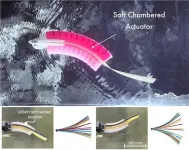
ELSE PRESS RELEASES FROM THIS DATE:
2021-03-23
THz waves have a plethora of applications ranging from biomedical and medical examinations, imaging, environment monitoring, to wireless communications, because of the abundant spectral information, low photon energy, strong penetrability, and shorter wavelength. THz waves with technological advances not only determined by the high-efficiency sources and detectors but also decided by a variety of the high-quality THz components/functional devices. However, traditional THz devices should be thick enough to realize the desired wave-manipulating functions, hindering the development of THz integrated systems and applications. Although metamaterials have been ...
2021-03-23
Tailoring light is much like tailoring cloth, cutting and snipping to turn a bland fabric into one with some desired pattern. In the case of light, the tailoring is usually done in the spatial degrees of freedom, such as its amplitude and phase (the "pattern" of light), and its polarization, while the cutting and snipping might be control with spatial light modulators and the like. This burgeoning field is known as structured light, and is pushing the limits in what we can do with light, enabling us to see smaller, focus tighter, image with wider fields of view, probe with fewer photons, and to pack information ...
2021-03-23
Distributed optical fiber sensing (DOFS) is currently a mature technology that allows "transforming" a conventional fiber optic into a continuous array of individual sensors, which are distributed along its length. Between the panoply of techniques developed in the field of DOFS, those based on phase-sensitive optical time-domain reflectometry (ΦOTDR) have gained a great deal of attention, mainly due to their ability to measure strain and temperature perturbations in real time. These unique features, along with other advantages of distributed sensors (reduced weight, electromagnetic immunity ...
2021-03-23
Light-emitting diodes (LEDs) are changing the lighting and display industry and have obtained significant advances than traditional lighting sources. The traditional materials LEDs, e.g., III-V semiconductor LEDs, organic LEDs (OLEDs) and quantum-dot LEDs (QLEDs), have achieved great success and gradually realized commercialization, but still face some challenges. The OLEDs have the low carrier transport capability and exciton recombination, which would hinder the improvement of brightness. Besides, QLEDs show challenges for the tedious manufacturing process and the reliance on hydrophobic insulating long ligands also hinders their stability and electrical conductivity.
Compared with these traditional materials, quasi-2D ...
2021-03-23
A large proportion of dementia deaths in England and Wales may be due to socioeconomic deprivation, according to new research led by Queen Mary University of London.
The team also found that socioeconomic deprivation was associated with younger age at death with dementia, and poorer access to accurate diagnosis.
Dementia is the leading cause of death in England and Wales, even during the COVID pandemic, and is the only disease in the top ten causes of death without effective treatment.
The research, published in the Journal of Alzheimer's Disease, examines Office for National Statistics mortality data for England and Wales, and finds that in 2017, 14,837 excess dementia deaths were attributable to deprivation, equating to 21.5 per cent of all dementia deaths ...
2021-03-23
Uncovering detailed travel patterns and habitat use of sharks along and across shelf territories has been historically challenging - especially for most pelagic shark species - which remain offshore for most of their lives. Their vertical diving behavior has been a subject of inquiry for a long time, and for young sharks in particular, has remained elusive.
Using cutting-edge 3D satellite technology, a study led by Florida Atlantic University's Harbor Branch Oceanographic Institute, in collaboration with NOAA's National Marine Fisheries Service; OCEARCH; The South Fork Natural History Museum and Nature Center; and the Wildlife Conservation Society, is ...
2021-03-23
Of the many perplexing questions surrounding SARS CoV-2, a mysterious new pathogen that has killed an estimated 2.6 million people worldwide, perhaps the most insistent is this: why does the illness seem to strike in such a haphazard way, sometimes sparing the 100 year old grandmother, while killing healthy young men and women in the prime of life?
A new study by Karen Anderson, Abhishek Singharoy and their colleagues at the Biodesign Institute at Arizona State University, may offer some tentative clues. Their research explores MHC-I, a critical protein component of the human adaptive immune system.
The research suggests that certain variant ...
2021-03-23
A NIMS research team devised a new thermoelectric generation mechanism with a hybrid structure composed of thermoelectric and magnetic materials. The team then actually fabricated this structure and observed the record-high thermopower appearing in the direction perpendicular to a temperature gradient (i.e., transverse thermoelectric generation). These results may offer insights into new mechanisms and structural designs applicable to the development of versatile energy harvesting technologies and highly sensitive heat flux sensors.
The Seebeck effect is a phenomenon in which a temperature gradient across a metal or semiconductor is converted into a thermoelectric voltage. Because this effect can be used to convert waste heat into electrical energy, its potential applications (e.g., ...
2021-03-23
Through an analysis of cellular components (cell fractions) from malignant ascites (fluid buildup in the abdomen caused by gastric cancer), a research collaboration based in Kumamoto University (Japan) has demonstrated that cellular senescence of cancer-associated fibroblasts (CAFs) play an important role in the peritoneal dissemination of gastric cancer foci (cells different from surrounding cells). This understanding should enable the development of new treatments for cancer dissemination in the peritoneum by targeting cancer cells at focal sites and CAFs in patients with gastric cancer.
Peritoneal dissemination ...
2021-03-23
Plant species with short generation times are more sensitive to climate change than those with long generation times. This is one of the findings of a synthesis study by researchers from the German Centre for Integrative Biodiversity Research (iDiv), the Martin Luther University Halle-Wittenberg (MLU) and the Helmholtz-Centre for Environmental Research (UFZ). The international team comprehensively compiled worldwide available data, mostly from Europe and North America, to address the question of how plant populations react to climate change. The study, published in Nature Communications, shows that plant characteristics such as generation ...
LAST 30 PRESS RELEASES:
[Press-News.org] Underwater swimming robot responds with feedback from soft 'lateral line'

